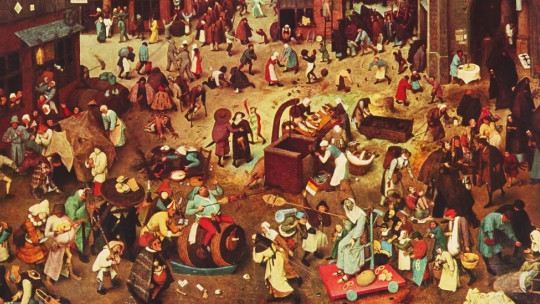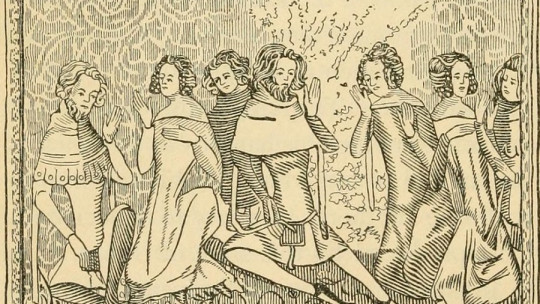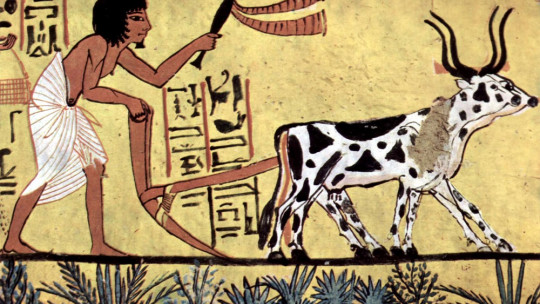The history of humanity is rich and complex, full of great achievements and great losses.
Human beings have evolved over time, facing a great variety of vicissitudes, learning along the way about how the world works and building different interpretive models of it. There are four great ages into which we can divide history (five if we also consider prehistory): Ancient, Middle, Modern and Contemporary.
Of all of them perhaps one of those that usually generates the greatest interest is the Middle Ages In this article we are going to briefly review the characteristics of the longest age in history, especially as it relates to the social and psychological level.
Delimiting the time period: the Middle Ages
We call the Middle Ages the historical period between the 5th and 15th centuries, being chronologically located between the Ancient Age and the Modern Age. This age of history is the longest there has ever been until now (if we do not consider prehistory), and it is considered to begin with the fall of the Western Roman Empire (that of Rome) in 476.
Its end also coincides with the fall of the Byzantine Empire (previously the Eastern Roman Empire) in 1453, although other authors date its end to the discovery of America (although discover would not be the exact word since civilizations already existed there) by Christopher Columbus in 1492.
This long period of time encompasses a large number of events that marked the future of history in one way or another, although the events that are taken into account practically have European territory and part of Asia as their protagonist. The Middle Ages can also be divided into different periods, being the High Middle Ages (which took place between the 5th and 10th centuries) and the Late Middle Ages (corresponding to the centuries between the 11th and the 15th).
During this stage there have been different advances and setbacks in different areas, different institutions, beliefs, cultures and even social classes being born and dying Religion plays a primary role, as do different political systems. It is also a time full of war conflicts (sponsored by political, religious and economic reasons), such as the Crusades or the Hundred Years’ War.
Although this is probably one of the most reviled periods, with many authors suggesting the existence of a regression in human development, the truth is that although in many aspects there were important setbacks, different ways of interpreting reality also originated and advances were made in different areas, despite doing so very slowly compared to later stages.
Characteristics of medieval society
The Middle Ages is a stage in which we can observe great divergences in a large number of parameters throughout its course. Likewise, there are many typical characteristics of this age that Over time they have changed and evolved (although some of them have remained during modernity and part of the contemporary age, and in fact have only changed in recent centuries).
In this sense, focusing on the social aspects and those of a more psychological nature, we can find the following distinctive elements.
1. The religious institution as a nucleus of power
One of the characteristics that probably stands out the most about this stage is the great power and consideration that religion obtains. Religious beliefs become basic elements in the daily life of the population, as well as a way to keep the population contained and limited to a specific model of reality.
Religious institutions, and specifically the Catholic Church, acquire a predominant role in society, being one of the few classes with access to education and with political power capable of surpassing that of the nobility, to the point of being a central axis of power in Europe at the time.
2. A theocentric world
Related to the above, we find a stage in which the world was explained fundamentally based on religious concepts, reality being the product of divine will and creation. This meant that God was at the center of everything, focusing society and a large part of philosophical efforts on understanding the world through divinity.
3. Fear and obedience to dogmas
Another aspect of great relevance is the existence of a high level of fear in the population, most of whom are illiterate and have little knowledge regarding the functioning of the universe and different natural phenomena. This also facilitated ascription to the only prevailing explanatory model to which they had access, the religious one to the point of reaching attitudes of fanaticism and persecution of that which departs from it.
Interpretations abounded that negative aspects of life or illness were consequences of demonic possession, sorcery, or magic. It is also a time of a high level of distrust towards the strange and foreign, especially towards what was not understandable.
In the same way, the high lack of medical knowledge and the emergence of major epidemics They were seen as divine punishments. Another frequent fear was that of the arrival of the end of times, experiencing its passage as something negative and worrying (especially around the year 1000 AD, due to the interpretation of the Bible).
4. The exacerbation of guilt, sin and virtue
Some fundamental concepts that governed the behavior of many during the time are guilt and sin. The fact of committing acts considered despicable for which they could be punished both in this life and especially after death permeated society. Containment and excessive control generated paranoid attitudes, occultism and persecution On the other hand, an ideal of the virtuous human being was promoted as a role model, in such a way that behavior was very delimited.
5. The Inquisition and the persecution of witchcraft
Perhaps one of the most hated and feared figures of the Middle Ages is that of the Inquisition, which is responsible for the persecution of what was considered heresy (such as positions that diverged from official dogmas) and witchcraft.
In this last aspect, the witch hunt stands out as something that generated a high level of persecution and suffering for a large part of the population. A large part of the illnesses, diseases and catastrophes were associated with the use of magic and sorcery, often blaming specific sectors of the population or people with marginal characteristics. Likewise, said persecution was used as a political tool to eliminate adversaries and to maintain tight control of the population.
6. The progress of science and scholasticism
Although in this aspect many people consider that the Middle Ages are a black point in scientific progress, the truth is that although scientific knowledge and its expansion were very slowed down, there were also numerous advances.
Although it is true that in medieval Europe the copying and transcription of classical figures of antiquity prevailed, research being secondary and generally linked to the study of zoology or spirituality, The scientific advances of the Arab world should not be ignored and that later they would be introduced little by little.
A particularly relevant aspect is the movement known as Scholasticism, which emerged in the 13th century. This current combined theology with classical philosophy with the purpose of coordinating faith and reason. Although in this relationship faith was always above, the truth is that it allowed the promotion of reasoning and reflection, and relevant figures of philosophy such as Saint Thomas Aquinas emerged from it.
7. Large social differences
In addition to religion, another of the great identifying factors of this era is the division into three large social classes (nobility, clergy and peasantry) and the existence of a great difference between the powers, roles and rights of each of them.
The peasantry comprised the majority of the population , their rights being minimal or non-existent. His role focused on providing and producing food by working the lands of his lords, being the working class that actually supported society. The rights of this sector of the population were minimal and they were part of the non-privileged, often being abused by other social classes and having to pay taxes.
The nobles were the highest class, being within the privileged classes and benefiting from special rights. They mostly did not work, and tended to run lands and businesses. They enjoyed positions of power and had access to education. They were also part of the army, generally as senior officers. In the feudal stage, they were the owners of the lands that the peasants worked, these being their vassals. Above them was the king (although during feudalism it was not uncommon for some feudal lords to have greater power than this).
Finally, The clergy also enjoyed a special position It was also a privileged class, which did not pay taxes and had access to positions of great power. This is the class with the highest level of education at the time. It was not uncommon for families to send one of their children to . Although at first they dedicated themselves only to prayer and study, over time they would also dedicate themselves to the work of their lands (with the well-known Ora et labora of the rule of Saint Benedict).
Another social group that is often ignored when talking about social classes is that of the slaves Although they already existed in ancient times, they were still seen as little more than properties that could be used at the whim of their “masters”.
8. A birth position
The social position that each person occupied was determined by their origin and family of birth, with the sole exception of the clergy. Someone born to nobles was noble and a son of peasants would be a peasant his entire life, with no possibility of changing social position in principle.
The exception was the clergy, and it was possible for those who entered it to assume a higher social position and change their social status. In fact, Among the lower classes it used to be one of the only ways to access education
9. The figure and role of women
Another aspect of great relevance to take into account is the role of women in the Middle Ages. This consideration was variable throughout this period, but as a general rule, women were below men and were subordinate to him. The idealization of feminine beauty and romanticism also emerged, giving rise to the literary figure of the “roman courtois.”
Likewise, women in this period had a function and role focused on the home and reproduction, although in the case of the peasantry they also worked in the fields. Socially, single women were frowned upon and it was often considered that there were three basic paths: marriage, the church or prostitution. As for the married woman, she owed obedience and submission to her husband
However, with the passage of time, great female figures emerged among the nobles and women who dedicated themselves to the Church, many being named saints or having great influence. There were also great queens with an influential role in political life, although often indirectly. During the Inquisition, there was also a greater preponderance of persecution of the figure of the witch, generally lonely women or widows.
10. The treatment of ethnic and religious diversity
As we have mentioned, during the Middle Ages the existence of a high level of fear and even psychoticism stands out, as well as great distrust towards the strange. This was reflected in the fact that people who did not comply with the standard model of behavior or their customs or features did not adhere to what they considered normal were persecuted and even attacked.
For example, ethnic minorities were persecuted and treated like animals (people of color, in fact, were mainly slaves). People with religions different from the official one were also persecuted or forced to convert , as in the case of Jews (who were frequently blamed for diseases and other disasters and attacked and murdered in Jewish quarters). The same thing happened with the Muslim minority in European territories (although in different periods and territories there was also peaceful coexistence).
11. Sex, a taboo
The treatment of sex is also a particular aspect of the Middle Ages. Sex was something that was socially hidden at an official level and not talked about. It was seen as something reserved for mere reproduction, and it was also highly scripted and standardized. Practices such as anal sex were the sin of sodomy, for example.
However, it was common to resort to the services of prostitutes and for men (especially nobles) to have one or more lovers. Female sexuality was something ignored and not valued , its enjoyment not being something contemplated even by the female sector itself. In them, adultery had severe penalties that could include being walled up.
With regard to sexual diversity, homosexuality and other behaviors different from heterosexuality were considered an aberration and were officially persecuted, especially during the period in which the Inquisition existed, with the sin of sodomy being considered serious and could entail severe consequences for those who be accused of such action.
12. Cultural creation
Although scientific knowledge was not particularly notable at the time, the truth is that cultural creation had great representatives in the Middle Ages.
Although in general almost all cultural aspects were focused on religion, in the case of architecture we find great advances over the centuries, different architectural styles such as Romanesque and Gothic were born Music was also important at this time, as was literary creation (although with some exceptions, people generally worked under pseudonyms).
13. The origins of the bourgeoisie
The majority of the European population lived in the countryside during the Middle Ages. However, over the centuries, little by little and to an increasing extent, the number of inhabitants of the towns increased. Likewise, jobs that were different from field work and that were of great relevance to society began to be generated, such as merchants and artisans.
These professionals little by little organized themselves into guilds , and with the passage of time they would end up generating a new social class: the bourgeoisie. This new class was not among the privileged classes, but it tended to concentrate a large amount of money and little by little it would become a basic element of the economy. Unlike the peasants, the bourgeoisie were much more likely to prosper and change their social position.
14. Education
Another characteristic aspect of the time is education. It was something minority, being permissible only for the nobility and the clergy in most cases. The methods used did not usually take into account the existence of individual differences in abilities, and the methodology was not adapted to the students. The contents discussed were subject to official dogmas , with the clergy being the main person in charge of educating the few who could do so. Mainly rote learning was carried out.
Likewise, the first universities (some of them in our territory) also emerged as such from the monastic schools. Grammar, Medicine or Law were, along with Theology, some of the subjects covered.
15. Treatment of mental illnesses and disorders
Illness was something extremely feared in the Middle Ages, with medical development being deficient. In many cases there was a quasi-mystical conception of the functioning of the body , and a simple cold or cut could be fatal. Exploring the inside of a human body was a crime and was harshly prosecuted, which meant that many diseases could not be treated or understood.
Many other disorders were poorly treated and the treatment used could even worsen the condition. The clearest example is the use of bloodletting or leeches, frequently used to purify blood. What was not known was that this also greatly weakened the patient, potentially worsening his condition and leading to death more easily.
Although medicinal properties of some plants were known, their use was not frequent. In fact, many people with knowledge of this type were accused and burned or hanged on charges of witchcraft.
Also in this sense, it stands out that the hygienic conditions were minimal, with a large number of lice, bedbugs, fleas and creatures with the potential to spread different diseases. This generated major plagues, including the Black Death
The treatment of mental disorders deserves special mention. Initially there was a charitable treatment, but over the centuries certain disorders were considered as demonic possessions or the effect of witchcraft, and the presence of exorcisms, torture or even burning at the stake to free the soul from the person of evil spirits.
16. The soul and the body
At this stage, it was considered that the human being was made up of soul and body, the soul including what we consider the mind today. Sensations or thoughts were acts of the spirit.
Both dualistic and monistic conceptions coexisted in this regard. The existence of differences between people at the level of soul characteristics is also explored Emotions, motivation and other aspects relevant to psychology would be worked on by authors such as Juan Luis Vives at the end of this age.









